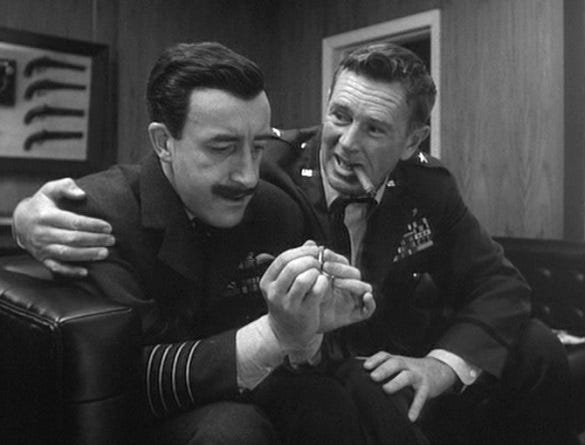Dr. Strangelove or: How I Learned to Stop Worrying and Love the Bomb
Stanley Kubrick’s “Dr. Strangelove or: How I Learned to Stop Worrying and Love the Bomb” is showing at 8 p.m. Friday, Feb. 12 at the Indianapolis Museum of Art. For more information, go to http://www.imamuseum.org/.

In my opinion, Stanley Kubrick is the greatest motion picture director who has ever lived. Consensus-wise, his “2001: A Space Odyssey” is the best science-fiction film ever, “A Clockwork Orange” is arguably the best horror film ever, and “Dr. Strangelove” the best satirical dark comedy. (I personally prefer Mike Nichols’ “Catch-22,” but that’s another discussion for another day.) This week, we have the opportunity to see the master at his absolute funniest when “Dr. Strangelove” hits the Toby Theatre at the Art Museum.
“Dr. Strangelove” concerns a disturbed Air Force General (Sterling Hayden) who orders a nuclear attack on the Soviet Union. It’s then up to the U.S. President (Peter Sellers) and his staff to advise the Soviets and recall the bombers. Our story follows the president and his advisors, the manic general and one of the bomber crews. Sound funny? Didn’t think so. But is it ever.
First, Kubrick made the brilliant move to not only star the greatest comedic actor of my lifetime, Peter Sellers, but to have him play three different roles. First, he’s the top assistant to Air Force General Jack D. Ripper, played to the hilt by the normally straight-laced actor Sterling Hayden. Ripper worries the Soviets have been secretly poisoning the U.S. water supply with fluoride, thereby contaminating the “precious bodily fluids” of all Americans. Hayden is so convincing spouting this nonsense that we almost feel obliged to take him seriously, up to a point. Ripper locks himself and his goodhearted but slow-witted assistant in a closet to prevent either of them from stopping the attack.
Sellers also plays President Merkin Muffley (Yes, I love these names too!), an ardent, amicable fellow whose phone call (on the “red phone”) to the Soviet premier ranks as one of the funniest scenes in motion picture history. Advising Muffley through this ordeal is General Buck Turgidson, played by another serious dramatic actor, George C. Scott. Don’t think he could ever merit a laugh? You haven’t seen Buck Turgidson. This guy personifies every stereotype we have of the American “real man.” Turgidson wouldn’t know quiche if it hit him in the face. What I particularly like about the Turgidson character is that once we’re properly introduced to him, he proceeds to spout pretentious platitudes that don’t exactly sound the way he means. And the dialogue between Sellers and Scott is priceless. Screenwriters Kubrick, Terry Southern and Peter George deserve a ton of credit for this treasured script.
Meanwhile, we follow one of the B-52 bombers and its crew, piloted by Major J.T. “King” Kong — a young, non-mustachioed Slim Pickens, in one of the funniest roles of his career. His final scene in “Dr. Strangelove” is one you’ll never forget.
Character actor Keenan Wynn plays Colonel “Bat” Guano, who manhandles his way into General Ripper’s office to try and call off the missiles. It is Guano who utters the best line of the entire film when an underling loses a dime (yes, just a dime) in a Coca-Cola machine.
At the end, Sellers appears again, this time as President Muffley’s science advisor, a wheelchair-bound former Nazi named Dr. Strangelove. It is this five-minute performance, perhaps even more so than his lifetime of Inspector Clouseau films, that enshrined Peter Sellers as a comedic genius. He should have won Best Actor for “Dr. Strangelove,” but, perhaps due to the horrific nature of the film, he lost to British stage actor Rex Harrison in “My Fair Lady” — a light, uplifting, crowdpleaser musical.
Unlike most Kubrick films, “Dr. Strangelove” is only 90 minutes long. It’s hard to believe all this action could be compressed into such a short running time, but you’ll never look at your watch. “Dr. Strangelove” is one uproarious romp from beginning to end. And it’s still pertinent today. Replace the Soviet Union with any number of rogue states, and it could be re-released today. Notice how I don’t say “remade.” Even without changing a word of the script, no one dare replace Sellers, or George C. Scott for that matter, without ruining one of the classic pictures ever made.
Andy Ray’s reviews of current films appear at http://www.artschannelindy.com/.



